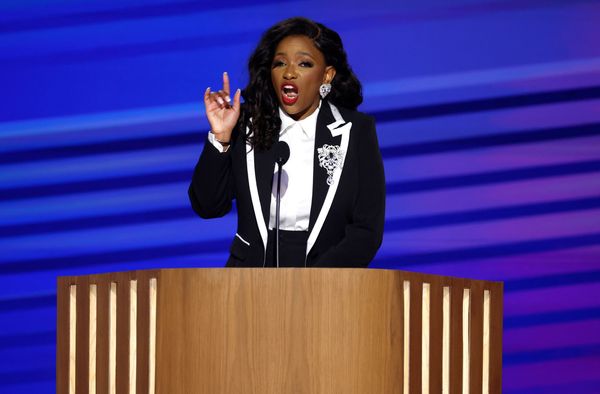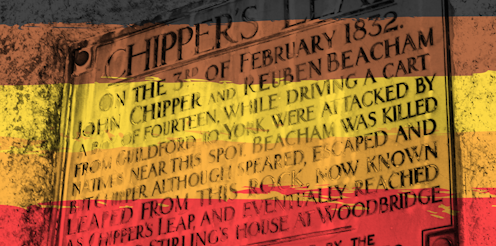
First Nations people please be advised this article contains distressing imagery of a retaliatory shooting.
Some commemorations across this continent, despite their original intentions, inadvertently testify to the fact that Aboriginal peoples did, in fact, “fight back” and that colonisation was, in fact, violent. These commemorations typically consist of graves, memorial monuments and even place names, and they are dedicated to white settlers who were “killed by Natives”.
These commemorations serve to uphold the pioneer legend that honours the brave settler and the characteristic representation of the “Natives” as being savage and vengeful, and their attacks unmotivated and unpredictable.
Typically, the events are decontextualised; there is no account of what led up to an incident, what actions by the settlers prompted the attacks made by Aboriginal peoples on them.
There is also usually no account of the retaliatory attacks that followed, where settlers sought retribution through the indiscriminate brutal massacre of Aboriginal peoples that went unpunished and largely undocumented.
In Port Lincoln, South Australia, there stands a monument that states:
ERECTED BY PUBLIC SUBSCRIPTION THROUGH THE PORT LINCOLN PROGRESS COMMITTEE IN MEMORY OF FRANK HAWSON AGED 10 YEARS WHO WAS SPEARED BY THE BLACKS OCTOBER 5TH 1840, BURIED IN TRAFALGAR ST 1840
RE-INTERRED UNDER THIS MONUMENT MARCH 30 1911.
ALTHOUGH ONLY A LAD HE DIED A HERO.
GONE. BUT NOT FORGOTTEN.
Frank’s remains were re-interred with a new monument when it was noticed that his grave was in a neglected state. Public subscriptions were invited so as to erect a more suitable monument, and particularly targeted school children “to whom the story of the lad’s end has been made known through a school publication”.
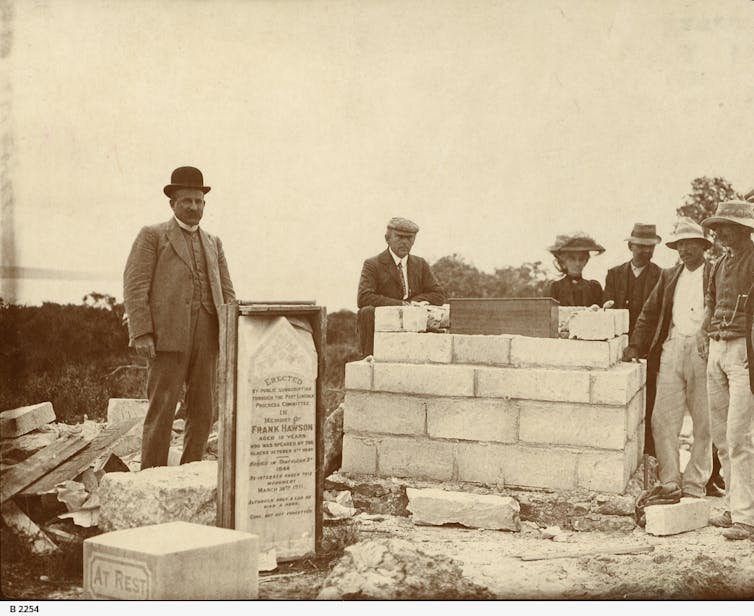
This was an opportunity to further the agenda of Black erasure and white permanence – to romanticise the frontier, to perpetuate the pioneer legend and demonise Aboriginal peoples as the murderers of innocent settler children.
So how did poor Frank die a hero? While the details are sketchy and vary depending on the source, an account published in a newspaper almost 100 years later states that Frank was left alone guarding a shepherd’s hut on the Hawson family’s station while his older brother Edward rode to Port Lincoln.
A group of “Natives” appeared, asking for food, and despite Frank giving them all that was on hand, they were not satisfied and tried to enter the hut. Despite firing a gun and wounding one of the attackers, Frank ended up with two spears embedded in the chest, which, once the attackers fled, Frank tried to remove by cutting and sawing the shafts, but to no avail. Frank then attempted to walk the four miles to Port Lincoln, but this proved too excruciating.
Frank returned to the hut and set the shafts in the fire in an attempt to burn them, which is where Edward, having returned, found the injured child. Edward sawed off the shafts and took Frank to Port Lincoln on horseback, to be attended by a doctor and a surgeon.
Upon noting the two barbed spears, one of which had passed through to Frank’s back, they both agreed that removal would be highly traumatic and would result in instant death. Instead, they chose to leave the spears in place and permit Frank, who allegedly claimed not to be afraid of death, “to die a lingering, but not a painful death in preference to a hasty and violent one”.
While this 1940 account makes no mention of the events that led up to the attack on Frank, it does note, interestingly, that Frank’s was the first murder of a settler on the Eyre Peninsula, and the shock of it was so profound that the governor, fearing “indiscriminate punitive measures”, felt it necessary to issue a proclamation against retaliation. Although this may have staved off any initial reprisal attacks, massacres of Aboriginal peoples in the region were to come later that decade.
The massacres that followed
Irene Hogan, a historian and descendant of the Hawson family, has managed to lend the legendary tale some balance by exploring what may have provoked the attack on Frank. On a website dedicated to the history of the Hawson family, Hogan notes that while early relations between the British colonists and local Aboriginal peoples appeared smooth, violent clashes soon erupted as a result of the British taking over land and preventing Aboriginal access to hunting and other food sources.
It is only in recent decades that recognition has been given to events that led up to Aboriginal attacks on white settlers, and notably to the reprisal massacres that followed.
Two particular Aboriginal attacks on white settlers, the Hornet Bank Massacre and the Wills Massacre, have been notorious for the role of the Aboriginal attackers. However, the notoriety has steadily shifted to those responsible for retaliatory attacks that followed: as historians have brought to light preceding and subsequent events surrounding the massacres, it has become apparent that surely the “massacre” is what followed.
The Hornet Bank Massacre, as it is known today, refers to the 1857 killing of 11 white settlers, eight of whom, including adults and children, were members of the Fraser family. A memorial at the grave site was erected at Hornet Bank in Taroom, Queensland, on the centenary of the massacre.
The attack was carried out by the Iman people of the region (also referred to as the Yeeman, Yiman, Eoman and Jiman), who had suffered numerous attacks by the settlers, including poisonings and shootings.
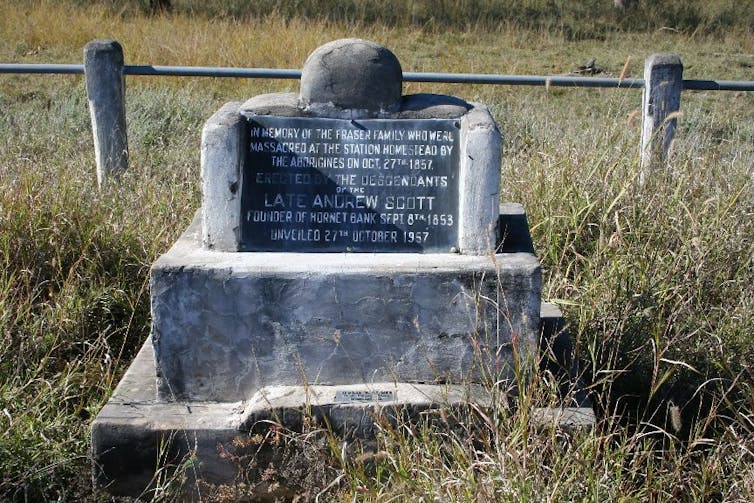
One of the Fraser children, aged 14, was injured but survived the attack. An older brother, William, who was away from the station at the time, “became obsessed with revenge and reprisal”.
William was joined by numerous other settlers in the region and, together with the Native Police, set out on a series of bloody and indiscriminate killing sprees. He was actively supported by the judicial system, and together their exploits were highly approved of by many other settlers on the frontier, which saw them promoted to hero status.
By March 1858 it was estimated that up to 300 Iman had been killed, and Aboriginal academic Eva Fesl has claimed the number was closer to 500.
Although it was believed that by the 1880s the Iman had been totally wiped out, this has been disputed, and descendants of this group have recently been recognised by the High Court of Australia as the original custodians of the land surrounding Taroom.
In 2012, research blogger Ingrid Piller highlighted that the reprisals following the Hornet Bank Massacre were more of a massacre than the event itself.
Piller noted that Wikipedia had an entry for “Hornet Bank Massacre” but none for “Iman Massacre” or similar, but it does appear in a “list of massacres of Indigenous Australians”. At the time of writing, the Monument Australia website lists no memorials to the massacre of the Iman, but does list the Hornet Bank Massacre memorial.
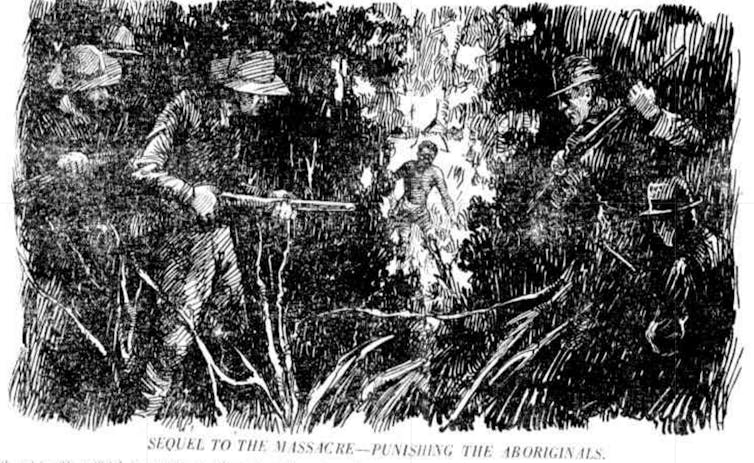
William Fraser, who died in 1914, was still held in high regard despite being reported to have personally killed more than 100 Aboriginal people, yet he is not listed among Australia’s mass murderers.
Repercussions and reprisals
The Wills Massacre refers to the 1861 killing of 19 white settlers by the Gayiri people on Cullin-La-Ringo Station near Springsure, Queensland – the largest recorded massacre of white settlers by Aboriginal people in Australian history. A sign to the entrance of the Cullin-La-Ringo historic site erected in 2009 states:
THIS IS THE SITE OF THE MASSACRE OF 19 PEOPLE BY A LOCAL ABORIGINAL TRIBE ON 17 OCTOBER 1861
THE PEOPLE KILLED WERE IN A PARTY LED BY HORATIO WILLS AND WERE RESTING IN THE EARLY AFTERNOON WHEN THE TRIBE MOVED INTO CAMP AND KILLED THE TEN MEN, TWO WOMEN AND SEVEN CHILDREN
The sign fails even to name the Gayiri people and provides no context as to why the massacre occurred, nor what happened after. White settlers had taken over precious water supplies, interrupted native animals and other food sources, and had disturbed sacred sites.
The Gayiri had suffered an attack by Native Police as punishment for allegedly stealing sheep – an accusation that proved to be false, as the sheep were found later. Unfortunately, Horatio Wills resembled the owner of the adjoining station, Jesse Gregson, who had joined with the Native Police in a series of massacres of Gayiri and is presumed to have been the actual target of their retaliation.
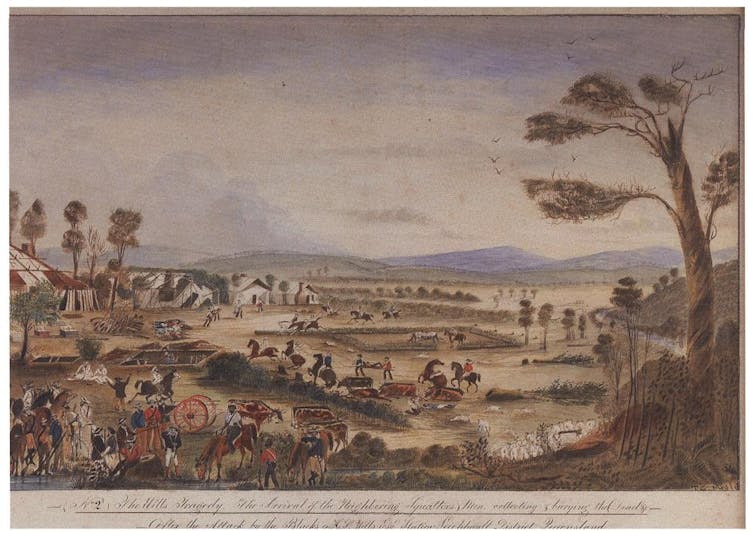
In response to the Wills Massacre, the colonial Queensland government reacted by sending seven Native Police detachments to the district. It is estimated that 300-400 Aboriginal people were killed, and further tens of thousands died as a result of the repercussions sparked by the government’s response.
The Wills Massacre is also seen as an important Aboriginal victory in the struggle against the settlers – it resulted in a dramatic setback for settler occupation of Aboriginal Country. Interestingly, Horatio’s child Cedric Wills blamed the massacre squarely on the actions of Gregson, the neighbouring station owner who had attacked the Gayiri.
Horatio’s other child, Tom Wills, who was away when the family was massacred, has until recently been recorded as having had no interest in participating in any retributions.
Instead, Wills went on to coach an Aboriginal cricket team from western Victoria that became the first “Australian” cricket team to tour England and became known as the pioneer of the Australian Football League game. However, recent research by sports history researcher Gary Fearon has unearthed a Chicago Tribune article from 1895 in which the author claims Wills spoke of his participation in reprisal massacres.
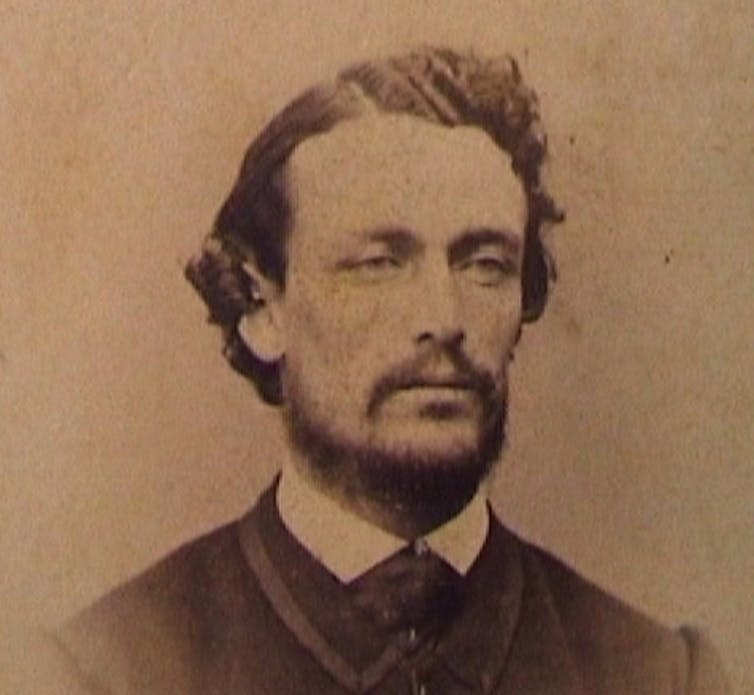
Testimonies of resistance
In some cases, commemorations to settlers “killed by Natives” have gained social significance for Aboriginal communities. In Northam, Western Australia, Noongar Country, a memorial grave tablet states:
CENTENARY OF WESTERN AUSTRALIA 1929 SACRED TO THE MEMORY OF PETER CHIDLOW AGED 35 YEARS AND EDWARD JONES AGED 30 YEARS WHO WERE KILLED BY NATIVES 15TH JUNE 1837.
IN THE MIDST OF LIFE, WE ARE IN DEATH
Chidlow and Jones had been working on a property that later became known as Katrine, when it is believed a group of Aboriginal warriors, angered by the arrest of some of their group, approached and demanded food. This resulted in an altercation, ending with both Chidlow and Jones being speared to death.
The tablet was erected in 1929 in celebration of the centenary of WA, but today is also revered by the local Aboriginal community for what it inadvertently represents – a testimony of Aboriginal resistance.
Other such testimonies are scattered across the continent. At Esk, Queensland, a stone cairn reads:
CAPTAIN PATRICK LOGAN
This plaque was erected in remembrance of Patrick Logan, an enthusiastic and energetic explorer of Southern Queensland.
Captain Logan made two expeditions up the Brisbane and Stanley Rivers, and visited the group of hills located to the east of this plaque naming them “Irwin’s Range”. This range includes the high rocky outcrop of “Glen Rock” located north-east of this plaque, and the peak of Mount Esk may be seen to the east from Glen Rock.
It is said that Captain Logan may have climbed Glen Rock the afternoon before he was attacked and murdered by Aborigines whilst camped at Logan Creek on 18 October, 1830.

The erection of this cairn and plaque was proposed and funded by Douglas Jolly, a person keenly interested in the history of Queensland, and a member of the Royal Historical Society of Queensland. He unveiled this plaque on October 28 1984.
Many people, possibly including Jolly who funded the cairn, regard Logan as the true founder of Queensland. The wording of the plaque suggests that the motivation behind erecting the cairn was certainly to record and honour Logan and his achievements, despite the fact Logan was also reportedly “hated by convicts and the Aboriginal population alike for his violence” and thereby “met a just end”, upon which “the jailed convicts celebrated with joyful singing for days”.
The cairn also now serves as a record of Aboriginal resistance.
At a place called “Chippers Leap”, formerly known as “Chipper’s Leap” (it’s all about the apostrophe), in Greenmount, WA, there is a heritage-listed commemoration consisting of a plaque on a rock that states:
CHIPPER’S LEAP ON THE 3RD OF FEBRUARY 1832, JOHN CHIPPER AND REUBEN BEACHAM A BOY OF FOURTEEN, WHILE DRIVING A CART FROM GUILDFORD TO YORK WERE ATTACKED BY NATIVES NEAR THIS SPOT.
BEACHAM WAS KILLED BUT CHIPPER, ALTHOUGH SPEARED, ESCAPED AND LEAPED FROM THIS ROCK NOW KNOWN AS CHIPPER’S LEAP, AND EVENTUALLY REACHED GOVERNOR STIRLING’S HOUSE AT WOODBRIDGE.
THIS TABLET WAS PLACED HERE BY THE WESTERN AUSTRALIA HISTORICAL SOCIETY. 1930.
In 1932, on the centenary of this incident, an article in the Swan Express criticised the erection of the commemoration, highlighting that Reuben Beacham had, in fact, been only 11 years of age and noting:
The story itself has no claim on public recognition, and is not of a nature to be handed down through the ages. The sooner it is forgotten the better. A strong, big boned, active man, Chipper was practically in the position of a father to the boy in the circumstances, yet he made not the least effort to save the child, but left him to his fate. In his official report, Chipper states that he heard the screams of the boy behind him, while he ran for his life. The boy was 11 years of age — a little chap he could have tucked under his arm!
The record is of interest only as a picture of early life in the State, and the boy Beacham is more worthy of recognition on the tablet. The work of the W.A. Historical Society is highly appreciated and the State is grateful to this body for its labors, but while so many deeds of self-sacrifice and bravery are left unrecorded, the story of Chipper is not one that should be told to our children.
The article concluded with a note that a “Mrs Cowan”, vice-president of the historical society, perhaps anticipating that not everyone would treat the commemoration with the respect the society felt it deserved, urged all present to combat vandalism.
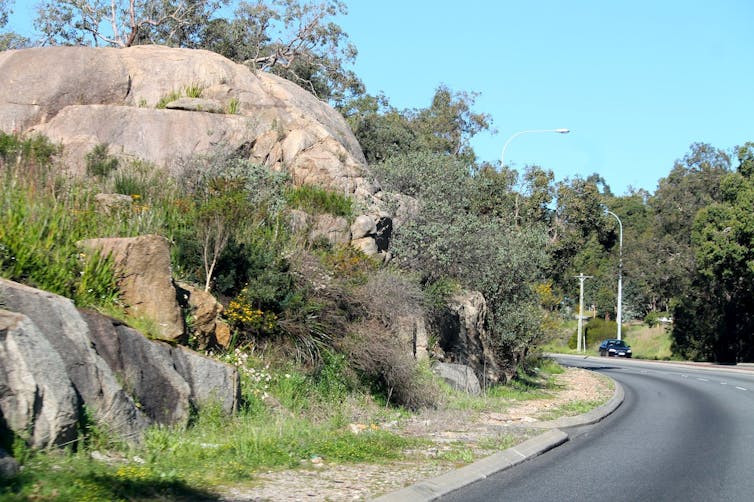
Chippers Leap was acknowledged as a site of significance during the 1988 Australian bicentennial commemorations, being included in the state’s Heritage Trail Program.
However, Elliott Chipper, the great-great-great-grandson of John Chipper, has acknowledged that this commemoration is an open attempt by the WA Historical Society to perpetuate the pioneer legend and foster a sense of pride in settler history.
Elliott Chipper identifies two stories that have been omitted from the plaque. One is that of Beacham — why is it not called “Beacham’s Rock”? He surmises this is because the image of a child dying on the side of the road just does not inspire a romantic sense of pride in the brave pioneer battling all manner of hostilities.
The other story is that of the Noongar people who were also involved in this event. Elliott Chipper notes that after John Chipper made it to Governor Stirling’s house, a large group of people were assembled to retrieve the child’s body and enact revenge on the Noongar people.
It was documented that 12 Aboriginal people were caught and hanged from the trees as punishment for the attack.
‘May your spirits live on and walk beside your people’
Over recent years, various communities have erected their own unofficial monuments commemorating the Frontier Wars. In Orford, Victoria, just metres from the town’s war memorial, is what is known as the Orford Aboriginal Memorial, which states:
IN MEMORY OF THE HUNDREDS OF ABORIGINAL MEN, WOMEN AND CHILDREN WHO LOST THEIR LIVES IN THIS AREA MAY YOUR SPIRITS LIVE ON AND WALK BESIDE YOUR PEOPLE NOW REST IN PEACE WUWUURK
The Aborigines of Port Phillip monument at Sorrento, Victoria, states:
In memory of Aborigines who were killed or wounded during the first British visits to Port Phillip Bay under the command of Lieutenant John Murray in 1803.
This was a breach of official British policy, which was to avoid conflict with Aboriginal people. At least one Aboriginal person, Bunja Logan, still bore old gunfire wounds when permanent settlers came to Port Phillip Bay in 1835.
At Woodford Bay, Longueville, New South Wales, the site of the first recorded meeting in the Lane Cove area between the Cameraygal people and the British in 1790, the Cameraygal Resistance monument in part states:
MEMORIAL PLAQUE TO HONOUR AND RECOGNISE THE CAMERAYGAL PEOPLE WHO DEFENDED THEIR COUNTRY BY RESISTING BRITISH INVASION
In Nunawading, Victoria, Wurundjeri-Balluk Country, the Year of Mourning Garden has a plaque that states:
IN MEMORY OF ALL KOORIE MEN, WOMEN AND CHILDREN MURDERED BY THE INVADER; KOORIE WOMEN & CHILDREN WHO WERE SEXUALLY ABUSED; KOORIE CHILDREN WHO WERE ABDUCTED AND NEVER FOUND THEIR PARENTS; KOORIES WHO WERE ENSLAVED AND THOSE WHO DIED THROUGH MALNUTRITION, POISONING AND INTRODUCED DISEASES. YEAR OF MOURNING 1988.
In 2007, in an area now known as the Murrup Brarn Yarra Flats Billabongs, just a few hundred metres from the Yarra Glen township in Victoria, Wurundjeri Country, a boulder with two plaques commemorates what is known today as the Battle of Yering. The memorial was organised by the Friends of the Yarra Flats Billabongs in conjunction with Yarra Ranges Friends in Reconciliation and Nillumbik Reconciliation Group. The plaques describe the battle:
“THE BATTLE OF YERING”
On the 13th of January 1840 an armed conflict took place on William Ryrie’s Yering Station between some 50 Wurundjeri clansmen and troopers of the Border Police led by Captain Henry Gisborne who had been dispatched from Melbourne by Superintendent Charles Joseph La Trobe to capture the charismatic Wurundjeri leader, Jaga Jaga.
Upon learning of Jaga Jaga’s capture the Wurundjeri approached the homestead with muskets and spears, whereupon Gisborne and his troopers mounted a counterattack, during which several shots were exchanged, forcing the Wurundjeri to retreat into the nearby billabong.
Having thus successfully drawn the troopers away from their imprisoned leader, others of the clan sped up to the homestead to quickly secure his release.
-Unveiled by Wurundjeri Ngurungaeta, Murrundindi, on the 13th January 2007.
At the unveiling, Wurundjeri Ngurungaeta (head person) Murrundindi noted the importance of acknowledging the events of the past and that while these events cannot be changed, they can be acknowledged and recognised.
In 2002, through community consultation and considerable effort from numerous Aboriginal peoples and their supporters, including the local reconciliation group Projects for Reconciliation, and with funding from Reconciliation NSW, a memorial garden at the St John of God Hospital in North Richmond, New South Wales, was created to commemorate the Battle of Richmond Hill.
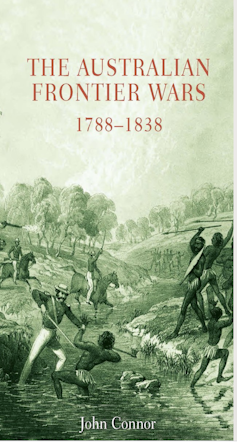
The Battle of Richmond Hill is described by John Connor in the book The Australian Frontier Wars 1788–1838 as possibly the first frontier war on this continent and the first recorded battle between Aboriginal people and settlers. According to Connor, it took place in an area the settlers had named Richmond Hill, along what they called the Hawkesbury-Nepean River, in May-June 1795.
The land belongs to the Dharug peoples, and the arrival of more than 400 settlers in the area in 1794 resulted in numerous crimes, including the destruction of native food sources, stealing Dharug children to work as unpaid labour and holding them against their will, the murder of Dharug people, and even the torture of a Dharug child.
The Dharug responded by killing settlers, raiding farms and taking corn. Raiding was so intense that Lieutenant-Governor William Paterson perceived it to be a serious threat to the future of the Hawkesbury settlement and ordered a detachment of the New South Wales Corps to kill any Dharug they found and hang their bodies on public display as a warning to others. The conflict that resulted took lives from both sides, even of children.
A permanent garrison was deployed to the region, the corps was expanded and troops were distributed among the farms to regularly seek out and kill Dharug. The Dharug became the first Aboriginal people to develop tactics for use specifically in frontier warfare, responding with a sustained campaign of raiding that lasted until 1805 and included stealing corn, attacking farmhouses, and using fire to destroy structures and crops.
Dharug knowledge-holder Chris Tobin, who was involved in establishing the Battle of Richmond Hill memorial, saw it as a step towards truth-telling and correcting common myths that there was no Aboriginal resistance to colonisation and that settlement was peaceful.
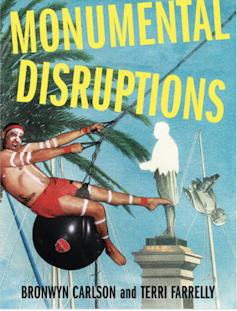
For youth who today are walking in the footprints of those who fought in the Battle of Richmond Hill, Tobin feels it is vital they learn about the efforts of those who came before them.
These were people who fought valiantly for their Country, who stood up for what was right, and their stories are something in which Aboriginal and Torres Strait Islander peoples and settlers can find pride. For Tobin, just knowing the memorial is there means the town is easier to live in.
This is an edited extract from Monumental Disruptions: Aboriginal people and colonial commemorations in so-called Australia by Bronwyn Carlson and Terri Farrelly (Aboriginal Studies Press).
The authors do not work for, consult, own shares in or receive funding from any company or organisation that would benefit from this article, and have disclosed no relevant affiliations beyond their academic appointment.
This article was originally published on The Conversation. Read the original article.





